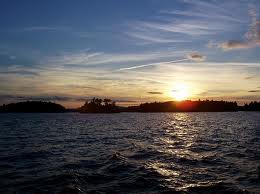Maine Lakes Through the Seasons

Salmon Lake, Belgrade & Oakland, Maine: Experience Rose-colored Sunsets
April 26, 2012
Out and About for the Mid Coast Lakes Regions of Maine May 3-9
May 2, 2012Maine Lakes Through the Seasons

Sunset on Refreshing Sebago Lake
Lakefront property owners who monitor Maine lakes for water quality testing from May through September, use a dissolved oxygen meter and sensing probe to determine the water temperature and oxygen at every meter. Cold water contains more oxygen than warm water. Fish, like salmon and trout, need the oxygen in the deeper, cooler water to survive. Too much algae growing in the warmer surface water may prevent that from happening. After algae die, they sink to the bottom of the lake where they are decomposed by bacteria, which use up the oxygen.
For the most part, lakes in Maine follow an annual density stratification/temperature cycle. As the weather warms in spring and the ice melts, the surface water heats up and therefore decreases in density. It’s called spring turnover when the temperature of the surface water equals that of the bottom water of the lake or pond.
After spring turnover, the surface water continues to absorb heat and warms so that the top layer becomes lighter than the water below. As summer progresses, we become much more aware of the temperature differences between upper and lower water layers. During this time deep lakes generally become physically stratified into three identifiable layers: epilimnion, metalimnion, and hypolimnion. The epilimnion is the upper, warm layer, and is typically well mixed. Some summers it feels like bath water in that top layer.
The middle layer is the metalimnion or thermocline region, a layer of water in which the temperature declines rapidly with depth. Between three and ten meters we usually find the thermocline–the transition point at which the temperature and oxygen levels of the lake suddenly change. You’ll recognize the thermocline on a summer day when you do a cannonball off the dock at your cabin or cottage and quickly pass from warm surface water to much cooler water.
The hypolimnion is the bottom layer of colder water. During the summer months, the density change at the thermocline acts as a physical barrier that prevents the top and bottom layers from mixing. Exposure to wind and the lake’s size determine the depth of mixing.
The surface layer or epilimnion cools in the autumn, reducing the density difference between it and the hypolimnion. Wind mixes the lake to greater depths, and the thermocline gradually deepens until the surface and bottom waters approach the same temperature and density. Like spring, this is the fall turnover of the lake.
The surface water continues to cool until it becomes less dense and freezes in early winter. During the winter a less distinct density stratification than that seen in summer develops under the ice. Just below the ice there is a thin layer of water that is less than 4°C, but greater than 0°C. Most of the lake below that is at 4°C.
Lake monitors collect samples, record data and educate local residents about ways to help maintain healthy lakes. Testing is not only important to properly identify current or potential issues, but also to establish data for future comparisons. This data allows waterfront property owners and users to make informed decisions regarding lake management.
Purchase a piece of Maine lakefront real estate and join the lake association to learn how you can help protect the water quality. To learn about lakefront property listings for classic Maine cabins and cottages located on Sebago Lake, just click on the green box above.
Other Blogs about the Sebago Lakes Region of Maine:
Sebago Lake Region, Windham, Maine: Lakefront Property Highly Valued
2010: A Good Year for Water Quality in the Sebago Lakes Region of Maine
